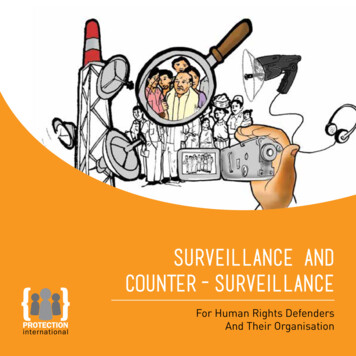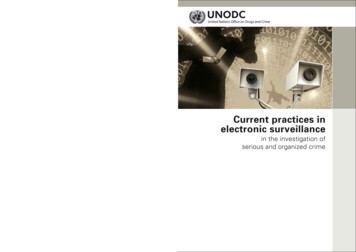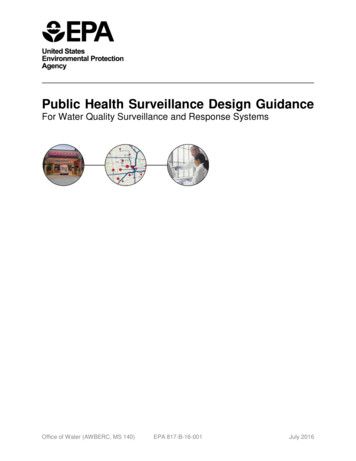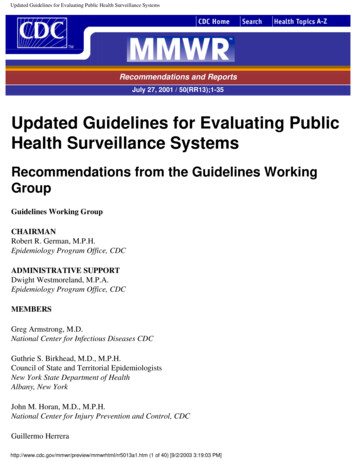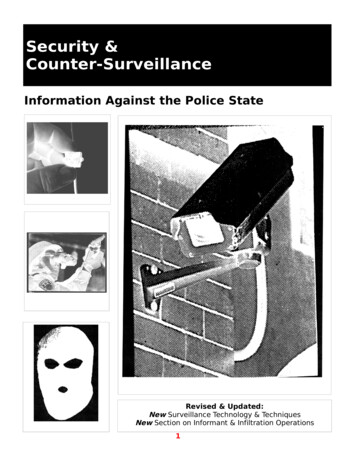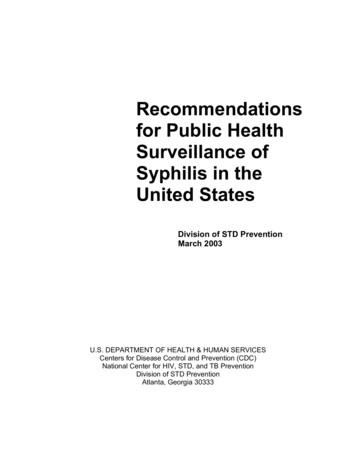
Transcription
Recommendationsfor Public HealthSurveillance ofSyphilis in theUnited StatesDivision of STD PreventionMarch 2003U.S. DEPARTMENT OF HEALTH & HUMAN SERVICESCenters for Disease Control and Prevention (CDC)National Center for HIV, STD, and TB PreventionDivision of STD PreventionAtlanta, Georgia 30333
Centers for Disease Control andPreventionNational Center forHIV, STD, and TB PreventionDivision of STD PreventionEpidemiology and SurveillanceBranchJulie Louise Gerberding, M.D., M.P.H.DirectorHarold W. Jaffe, M.D.DirectorHarold W. Jaffe, M.D.Acting DirectorStuart M. Berman, M.D., Sc.M.ChiefSurveillance and Special StudiesSectionHillard S. Weinstock, M.D., M.P.H.ChiefRecommendations for Public Health Surveillance ofSyphilis in the United StatesRichard H. Kahn, M.S.CoordinatorIII
Copyright InformationAll material contained in this report is in the public domain and may be used andreprinted without special permission; citation to source, however, is appreciated.Suggested CitationCenters for Disease Control and Prevention. Recommendations for Public HealthSurveillance of Syphilis in the United States. Atlanta, GA: U.S. Department of Health andHuman Services, March 2003.Copies can be obtained from the Training and Health Communications Branch,National Center for HIV, STD, and TB Prevention, Centers for Disease Control andPrevention, 1600 Clifton Road, Mailstop E-06, Atlanta, Georgia 30333. Printed copies canalso be obtained through the Internet on-line ordering system at the web site listed below.This report is atheCDChomepageat:
Table of ContentsExpert Consultants . viiExecutive Summary .1Introduction.3General Principles .4Components of Syphilis Surveillance .4Purposes and Uses of Syphilis Surveillance .4Case Reporting .4Prevalence Monitoring .6Case Definitions .7Case Reporting.12Sources of Case and Serology Reports.12Reporting Formats and Intervals .12Reactor Grid Analysis.13Provider-Based Case Reporting .14Laboratory-Based Case Reporting .15Evaluating Laboratory-Based Reporting.16Active Surveillance .19Purposes and Uses of Active Surveillance .19Genital Ulcer Surveillance .21Outbreak Detection .22Electronic Reporting of Laboratory Data .23Prevalence Monitoring .25Priority Populations.25Calculation and Definition of Seropositivity and Prevalence .26Provider-Based Prevalence Monitoring .27Laboratory-Based Prevalence Monitoring .27Reporting Formats and Intervals .28Behavioral and Social Surveillance .29Purposes and Uses of Behavioral and Social Surveillance .29Existing and Potential Data Sources.29V
Data Elements.30Data Collection Methods .31Analysis and Interpretation of Behavioral and Social Data .32Community Involvement with Data Collection, Analysis and Interpretation .32Data Quality.32Data Quality for Case Reporting .32Data Quality for Prevalence Monitoring .33Data Analysis and Interpretation .34Case-Reporting Data.34Prevalence-Monitoring Data.36Assessment of Screening Coverage .36Dissemination and Communication of Findings .37Case-Reporting Data.37Prevalence-Monitoring Data.37Information Systems.38Information System Design .38Privacy and Data Security .39Training and Personnel .40Appendix 1: Sample Serology Laboratory Site Visit Report.43Appendix 2: Prevalence Monitoring Data Elements.49Table 1 Minimum Data Elements .49Table 2 Enhanced Data Elements .49VI
Expert ConsultantsChairpersonsPaul EtkindJames GibsonMassachusetts Department of Public Health(NationalCoalition of STD Directors)South Carolina Department of Health(Council of Stateand Territorial Epidemiologists)State PresentersKaren ArrowoodRoxanne BarrowJames BeallGail BolanPeter CarrMichael CassellCarol CiesielskiDee CordovaDennis DorstMartin GoldbergDara GonoczyRobert GunnRobert KohnAlan LockeLinda MattocksPeter MooreAndrea MyersJohn PaffelPhillip PowersMichelle RoseSteve RubinDavid SullivanCraig ThompsonMark TurnerAnthony WadeMichael WhelanDel WilliamsDuane WilmotNew Jersey Department of Health and Senior ServicesGeorgia Department of Human ResourcesIndiana State Department of HealthCalifornia Department of Health ServicesMinnesota Department of HealthMississippi State Department of HealthChicago Department of Public HealthSt. Lucie County Health Department, FloridaLouisiana Department of Health and HospitalsPhiladelphia Department of Public HealthMichigan Department of Community HealthSan Diego Department of HealthSan Francisco Department of Public HealthWisconsin Department of Health and Family ServicesOhio Department of HealthNorth Carolina Department of Health and HumanServicesNew York City Department of HealthHouston Health and Human Services DepartmentArizona Department of Health ServicesConnecticut Department of Public HealthNew York City Department of HealthPennsylvania Department of HealthMississippi State Department of HealthOklahoma State Department of HealthWisconsin Department of Health and Family ServicesMassachusetts Department of Public HealthNorth Carolina Department of Health and HumanServicesMarion County Health Department, IndianaCDC PresentersJohn AndersonStuart BermanVII
Scott DanosLyn FinelliKimberley FoxKatrin KohlEmilia KoumansAnthony MarfinKristen MertzVickie PopeKaren SouthwickDorotha ThomasSamantha WilliamsModeratorsJoy EwellDaniel GeorgeCarol LangleyJean MontesJohn PotteratCornelis RietmeijerLouisiana Department of Health and HospitalsFlorida Department of HealthIndiana University School of MedicineCalifornia Department of Health ServicesEl Paso County Department of Health & Environment,Colorado Springs, ColoradoDenver Public HealthConsultantsMichelle Amar-HarriedMark AubinMark BarnesWayne BraithwaiteKyle BursteinNelson ColonDon ConnerWayne CrabtreeJoHanna DavisDebra FredricksonChris FreemanAl GonzalesTheresa HenryPaul HessAmy HoltermanNancy HoytDmitry IvanovDavid JohnsonBill LeveretteTim LindmanVIIIWashington D.C. Department of HealthWashington State Department of HealthArkansas Department of HealthBaltimore City Health DepartmentCalifornia Department of Health ServicesPuerto Rico Department of HealthSt. Louis City Department of Health and HospitalsLouisville-Jefferson County Health Department,KentuckyConnecticut Department of Public HealthOklahoma State Department of HealthDavidson County Health Department, TennesseeDallas County Health Department, TexasVirginia Department of HealthBaltimore City Health DepartmentMissouri Department of HealthMaryland Department of Health and Mental HygieneNew Jersey Department of Health Senior ServicesGeorgia Department of Human ResourcesSouth Carolina Department of Health and EnvironmentalControlSouth Carolina Department of Health and EnvironmentalControl
David LundbergRob MasonBruce NowakGlen OlthoffTerry PetersonAlex PhillipsMichelle PriebeDavid RainesMike RamageEd RenierCristol SimmonsAlice StudzinskiElbia TiradoRichard WhitleyTennessee Department of HealthVirginia Department of HealthDetroit Department of HealthMaryland Department of Health and Mental HygieneMontana Department of Public Health and HumanServicesPhiladelphia Department of Public HealthArkansas Department of HealthKentucky Department for Public HealthAlabama Department of Public HealthIllinois Department of Public HealthChicago Department of HealthIllinois Department of Public HealthPuerto Rico Department of HealthNevada State Department of Human ResourcesLiaison ParticipantsMarcia GomezWarren HewittArnette WrightHealth Resources Service AdministrationSubstance Abuse Mental Health Services AdministrationHealth Resources Service AdministrationCDC/Division of STD Prevention Meeting CoordinatorsJean HoganRichard KahnWilliam LevineIX
Executive SummarySyphilis is a genital ulcerative disease that facilitates HIV transmission and if untreated duringpregnancy may lead to fetal infection or perinatal death. In the United States syphilissurveillance is based on mandatory reporting from health care providers and laboratories to stateand local health departments. Recommendations for national syphilis surveillance weredeveloped by a group of invited experts who met in Atlanta on March 20-22, 2000. Thisconsultation on “Recommendations for Public Health Surveillance of Syphilis in the UnitedStates” was cosponsored by CDC’s Division of STD Prevention (DSTD), National Center forHIV, STD and TB Prevention (NCHSTP); the National Coalition of STD Directors (NCSD); andthe Council of State and Territorial Epidemiologists (CSTE). The recommendations, which aresummarized below, were developed for state and local public health programs. The intention ofthis report is to make the collection and reporting of syphilis surveillance data more uniform sothat data from a variety sources are comparable.Case Reporting State and local jurisdictions should adopt the CSTE and CDC surveillance casedefinitions for syphilis to ensure the quality and comparability of surveillance data.1 Syphilis cases should be categorized and reported by stage at the time of initialexamination (which is often the time of initial specimen collection), not at the time oftreatment or interview. All cases of probable or confirmed syphilis should be reported as morbidityregardless of treatment or interview status. Stage determination should be based onavailable clinical and serological information. In the absence of symptom or serology history, sex partners for the last year shouldbe evaluated to determine whether the case should be classified as early latent, latelatent, or latent of unknown duration. The following should be reported to the local health department within one workingday by public and private providers and laboratories: All probable or confirmed cases of early (primary, secondary or earlylatent infection) syphilis (regardless of treatment status). All reactive, nontreponemal laboratory tests. All confirmatory treponemal test results should be reported when available, but theiravailability should not delay reporting a reactive nontreponemal test result. Health Department Follow-up: Individuals with reactive serologies who are known or suspected ofhaving lesions should be contacted for follow-up regardless of age,sex, or titer. All women with reactive serologies who are known to be pregnantshould be contacted for follow-up regardless of age or titer. All women of child-bearing age (less than 45 years of age) withreactive serologies should be contacted for follow-up, regardless oftiter.Recommendations for Public Health Surveillance of Syphilis in the United States1
All adolescents ( 20 years old) with reactive serologies should becontacted for follow-up regardless of titer. Individuals with reactive serologies indicating a four-fold titer increasefrom a previous serology should be contacted for follow-up regardlessof age or titer.The reactor grid is an administrative tool used to prioritize follow-up of reactiveserologic tests for syphilis. Reactor grids should be evaluated annually or more frequently if thelocal epidemiology of syphilis changes. Prospective reactor grid evaluations should be completed at leastevery two to three years. In areas with substantial syphilis morbidity, reactor grids should beevaluated twice annually to assess the effectiveness and sensitivity ofthe grid.Prevalence Monitoring Syphilis prevalence data should be used to assess the yield of specific screeningactivities by identifying the number of new cases detected in relation to the numberof screening tests performed. In addition to screening assessments, syphilisprevalence monitoring at local, state, and national levels should be used to: monitor disease burden and trends identify populations with high rates of infection evaluate case-report surveillance dataData Analyses and Dissemination2 In areas with substantial morbidity, surveillance data should be analyzed at leastmonthly to monitor changes in incidence or new patterns of disease. In low morbidity areas, cases should be reviewed as reports are received and amonthly overview should be routinely completed to monitor changes in incidence orpatterns of disease. At a minimum, data should be analyzed by demographic and risk behaviorcharacteristics, including gender of sex partners. A plan for regular dissemination of information derived from the analysis of syphiliscase-reported data and prevalence data should be developed at local, state, andnational levels.Recommendations for Public Health Surveillance of Syphilis in the United States
IntroductionIn 1999, the Division of Sexually Transmitted Disease Prevention (DSTD) at the Centers forDisease Control and Prevention (CDC) announced a national plan to eliminate syphilis from theUnited States.2 The national plan established specific goals of reducing the number of primaryand secondary syphilis cases to 1,000 or fewer and increasing the number of syphilis-freecounties to 90% by 2005. The national plan outlines five strategies critical to achieveelimination: 1) enhanced surveillance, 2) strengthened community involvement andpartnerships, 3) rapid outbreak response, 4) expanded clinical and laboratory services and 5)enhanced health promotion.In response to the national plan, and particularly, the inclusion of “enhanced surveillance” asa cross-cutting strategy, a national meeting was sponsored in March of 2000 by the DSTD/CDC,the National Coalition of STD Directors (NCSD), and the Council of State and TerritorialEpidemiologists (CSTE) to develop guidelines for syphilis surveillance. Meeting consultantsincluded representatives from the 32 CDC funded syphilis elimination sites and representativesfrom NCSD and CSTE. Consultants were assigned to one of five workgroups formed to addressthe following issues: 1) case reporting, 2) prevalence monitoring, 3) congenital syphilis, 4) activesurveillance and outbreak detection and 5) behavioral and social surveillance. Key questionswere developed for each workgroup, and consultants were provided background materials(e.g.,published manuscripts, abstracts, and material presented at professional meetings) inadvance of the meeting to help them address the key questions. Recommendations weredeveloped based on the workgroups’ responses to the key questions.While surveillance must be tailored to the level of syphilis morbidity in a given jurisdiction, animportant objective for national syphilis surveillance is to assure consistency of surveillancepractices among states. In communities where syphilis has been absent for years, the focus ofsurveillance should be the identification of clinical symptomatic syphilis (primary syphilispresenting as genital ulcer disease or secondary syphilis presenting as rash). For such a focus,public health officials need to enlist the support of practicing clinicians who will be the first to seesuch cases. In such communities, serologic surveillance is not likely to be a particularly efficientapproach. For those communities with continuing endemic syphilis, expanding serologicscreening to high-risk populations and implementing or enhancing many of the traditionalsurveillance and control activities are essential.This report provides updated syphilis surveillance guidelines for health department personnelto use in improving and developing syphilis surveillance techniques. Although reporting syphiliscases is mandated by state laws and regulations in the United States, and information aboutsyphilis cases is reported to CDC from all states and territories, the usefulness of surveillancedata has been limited by the lack of uniform public health surveillance practices. The intention ofthis report is to make the collection and reporting of syphilis surveillance data more uniform sothat data from a variety sources are comparable.Recommendations for Public Health Surveillance of Syphilis in the United States3
General PrinciplesComponents of Syphilis SurveillanceSurveillance for syphilis has two main components: Case reporting: the process of reporting cases (or reactive serologic laboratoryresults) of notifiable infectious diseases by providers or laboratories to local and statehealth departments and from state health departments to CDC. Prevalence monitoring: monitoring trends in prevalence in defined populations overtime, where prevalence is the proportion of persons in a population that has thedisease or condition at a specified point in time.In contrast to case reporting, which is intended to be population-based, prevalence monitoringfor syphilis is generally performed using data obtained from selected populations. Prevalencedata are usually collected systematically from routine screening rather than from special studiesperformed for the primary purpose of assessing disease burden. The specific purposes of casereporting and prevalence monitoring are discussed in the following section, and the selection ofpriority populations for monitoring prevalence is discussed later in this report.Purposes and Uses of Syphilis SurveillancePublic health surveillance is the ongoing and systematic collection, analysis, and interpretationof health data in the process of describing and monitoring a health event.3 Surveillance data areuseful for a variety of reasons, including the planning, implementation, and evaluation of publichealth programs and interventions. Syphilis surveillance data have traditionally relied on casereporting from providers and laboratories. Prevalence monitoring data for syphilis and otherSTDs have provided an additional perspective on disease occurrence in some populations.Behavioral and social surveillance data have been used to identify and monitor risk exposures ofat-risk and infected populations.Case ReportingThe purposes and uses of syphilis surveillance using case-reporting data at local, state, andnational levels are:4 to monitor rates and trends of infection; to identify outbreaks rapidly; to identify persons at high risk for syphilis and the affected communities in whichthey live; to identify characteristics of infected persons and generate hypotheses regarding riskfactors; to identify gaps in health care and missed opportunities for interventions; to demonstrate the need for funding of syphilis control programs; to design and target interventions.Recommendations for Public Health Surveillance of Syphilis in the United States
At the local and state levels, case-reporting data should be used: to identify major providers or major laboratories that are or are not testing orreporting; to assure proper diagnosis, treatment, and partner management for all persons withearly syphilis; to identify persons at risk for HIV infection; to assess the effectiveness of syphilis prevention and control programs; to assess patient management (ensure proper evaluation and treatment of personswith syphilis); to evaluate the effectiveness of prenatal syphilis screening in preventing congenitalsyphilis.Monitor rates and trends of infection. Data obtained from case reports provide aminimum estimate of the burden of syphilis in the general population. The usefulness of thesedata for monitoring trends in disease burden is limited by three factors: a) the proportion ofinfected persons who seek medical attention because of symptoms; b) the extent to which thenumber and characteristics of asymptomatic persons screened remain stable over time; and c)the variability of reporting by providers and laboratories.Identify outbreaks rapidly. An important use of case-reported data is determining whetherincreases in numbers of cases suggests an outbreak of disease that requires immediateinvestigation.Identify persons at high risk for syphilis and the affected communities in whichthey live. Analyses of case-report data indicate that rates of syphilis vary by age, race orethnicity, geographic place of residence, and type of health-care provider. These data should beused to identify persons at increased risk for syphilis infection and to develop interventions andscreening criteria.Identify characteristics of infected persons and generate hypotheses regarding riskfactors. Information collected routinely through case reporting often provides valuableepidemiologic information with regard to the “person, place, and time” links that help identifycharacteristics of infected persons and aid in generating hypotheses.Identify gaps in health care and missed opportunities for interventions. Informationon prenatal care, testing, treatment, and follow up should be collected in case reports of earlysyphilis and congenital syphilis to allow local areas to identify gaps in care, to assess availabilityand use of these services for men and women at high risk of acquiring syphilis, and to developinformative programs for providers and outreach activities targeting high-risk populations.Demonstrate the need for funding syphilis control programs. Surveillance dataobtained through case reports may be used to demonstrate the need for continued or increasedfunding of syphilis prevention and control programs.Identify major providers and laboratories that are or are not testing or reporting.Many state and local STD prevention programs maintain a registry of licensed laboratories andproviders. Periodic analyses of syphilis case-reporting data by both providers and laboratoriescan identify variations in reporting that may require intervention by the health department.Providers and laboratories that do not report syphilis cases or that do not participate in efforts toRecommendations for Public Health Surveillance of Syphilis in the United States5
monitor syphilis prevalence can be identified by comparing the registries with information fromcase-reporting and prevalence-monitoring systems. Those providers and laboratories not testingor reporting should be contacted.Assure proper diagnosis, treatment, and partner management for all cases of earlysyphilis. At local and state levels, STD prevention programs need to contact persons infectedwith syphilis or the reporting health care provider to ensure that patients with early syphilis arestaged correctly, treated with appropriate therapy, offered partner-management services toprevent reinfection from and additional transmission by sex partners, and to ensure that exposedcontacts are evaluated and treated appropriately.Identify persons at increased risk for HIV infection. Persons infected with primarysyphilis have an increased risk of acquiring HIV infection, and persons infected with HIV whoare co-infected with primary syphilis are more likely to transmit HIV.4 A diagnosis of syphilis isalso an indication that the infected individual has had unprotected sexual contact with at leastone other person. Consequently, case reporting can help identify individuals and populationsubgroups that may also be at high risk for HIV infection. This would assist health departmentpersonnel in their efforts to focus prevention and intervention activities.Assess the effectiveness of syphilis prevention and control programs. Trends inreported cases may provide one measure of the effectiveness of disease control programs.3Careful analyses of specific disease control initiatives using reported cases over time as anoutcome measure may provide a sensitive assessment of the effectiveness of specificinterventions. However, consideration of social, behavioral, and other secular trends is importantwhen interpreting data for this purpose.Prevalence MonitoringSyphilis prevalence data have traditionally been used to assess the yield of specific screeninginitiatives by identifying the number of new cases detected in relation to the number of screeningtests performed. In addition to screening assessments, the purposes and uses of syphilisprevalence monitoring at local, state, and national levels are: to monitor disease burden and trends;to identify populations with high rates of infection;to evaluate case-reporting surveillance data;to design and target interventions;to allocate public health resources.Monitor disease burden and trends. A primary objective of surveillance is to monitor theoccurrence of disease over time within specific populations. Prevalence-monitoring data can beused to estimate the prevalence of disease in specific populations that are routinely screened forsyphilis. Disease trends in specific populations can often be measured with greater accuracy byusing prevalence-monitoring data than by using data from case reports because the screenedpopulations are better defined. Trends in prevalence in the population(s) screened may provideinsight into trends in similar populations in the community.Identify populations with high rates of infection. Prevalence data for syphilis suggestthat demographic and behavioral characteristics are associated with a high prevalence ofsyphilis. Therefore, prevalence monitoring may be useful in developing syphilis control and6Recommendations for Public Health Surveillance of Syphilis in the United States
intervention programs. However, it may not be possible to generalize the results to populationsfor which no prevalence data exist.Evaluate case-reporting data. Prevalence data provide an accurate measure ofdisease prevalence within the screened population. Prevalence data are less likely to bebiased by the under-reporting inherent in case-reporting data. Under-reporting can result inbiased estimates of disease occurrence when case-reporting data are used alone. Substantialvariation between estimates based on case reporting and estimates based on prevalence datawithin defined populations may indicate inadequate reporting or screening, or both.Design and target interventions. Prevalence data can provide information on
Prevalence Monitoring Syphilis prevalence data should be used to assess the yield of specific screening activities by identifying the number of new cases detected in relation to the number of screening tests performed. In addition to screening assessments, syphilis prevalence monitoring at local, state, and national levels should be used to:

